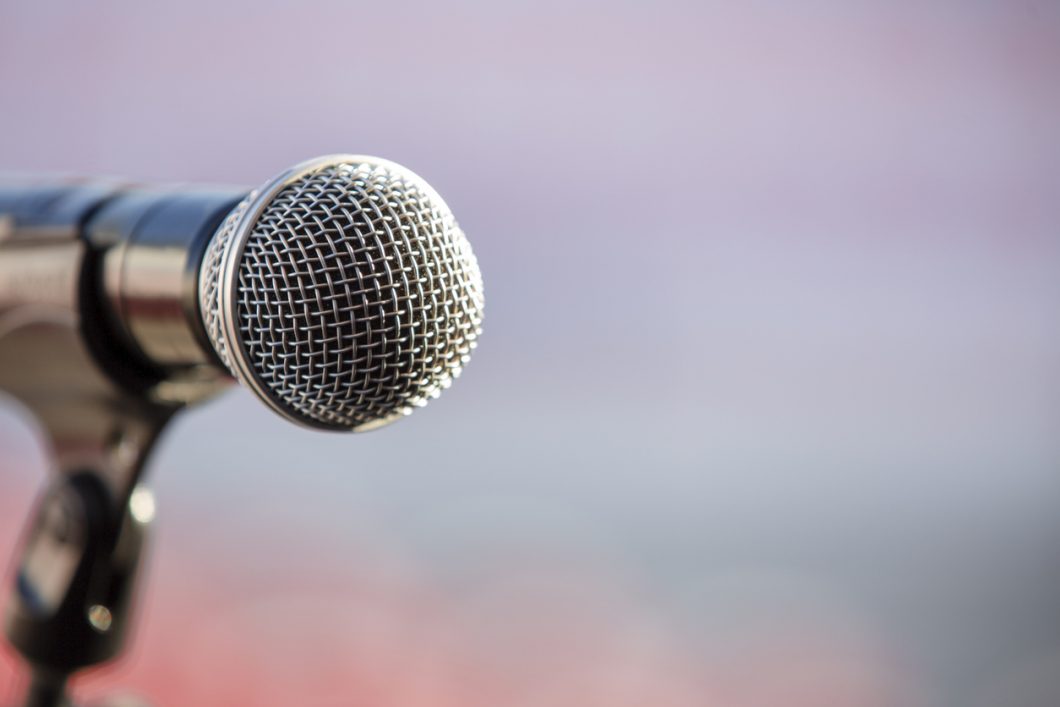
In 2013, reporter Sonia Narang visited a village in rural Nepal to meet Bimala Parajuli, a volunteer health worker who was helping to reduce the risk of babies dying from infection. The resulting online news story described, in words, Parajuli’s two-hour journeys to deliver antiseptic gel to mothers, hiking in sandals along steep mountainsides and on washed-out roads.
But in an audio version of the story, Narang used sound to bring listeners even closer to Parajuli. She recorded the clinking and shuffling of Parajuli packing her bag, the creak of the door as she left her home, and her footsteps on the dirt path. You felt like you were with her, Narang says. And Parajuli’s personality came through in her voice when she greeted a pregnant woman in melodic Nepali.
Audio allows characters to tell their own stories, Narang says, an aspect of the medium that is especially meaningful in stories that journalists often overlook. “I want to hear that person—in their voice—and give them representation,” says Narang, an independent radio and multimedia journalist.
Branching into audio storytelling gives print journalists new ways to invite an audience into a world. It’s “more intimate than the written word,” says Rebecca Hersher, a science journalist at NPR in Washington, DC. Radio and podcast segments can use sounds to convey the scientific process, ranging from the roar of research vessels cruising the ocean to the clunks of geologists moving rocks with tools. Listeners also can hear researchers’ enthusiasm as they describe a moment of discovery or insight. That excitement can create an emotional connection and helps listeners feel like they’re on a narrative journey with the scientist, says Rose Eveleth, creator and host of the podcast Flash Forward.
Making audio stories is time-consuming, and building skills requires many hours of practice. But training workshops and a supportive community of audio reporters can help newbies gain their footing and eventually land freelance assignments. For print journalists who commit to learning the medium, audio can open up another storytelling toolbox.
“If you enjoy describing the world using words, then having that extra dimension of tone of voice and ambient sound is really exciting,” Hersher says.
Developing an Ear
To get a feel for how pieces are put together, print reporters can begin by listening carefully to many podcast episodes and radio stories.
Studying scripts can help print journalists mentally shift to writing for a spoken medium. Audio involves shorter, easier-to-follow sentences, and stories need to be linear because jumping around on a timeline may be confusing. Listeners can’t follow links and may not be able to rewind, so it’s particularly important to explain complex concepts and jargon in a straightforward, step-by-step manner. And brevity matters: People will turn off a show that doesn’t hold their attention. “You leave a lot on the cutting room floor,” Hersher says. Even more so than with print, “you need to be ready to kill your darlings.”
To become more comfortable with the medium, journalists can start making audio pieces for themselves, without necessarily any intention of placing the stories with an outlet. Newbies can practice creating segments with sounds they’ve recorded, interviews they’ve done for print stories, or audio files found online. These exercises can eventually form the beginnings of a portfolio on SoundCloud or a personal website, which may later help with landing assignments. However, before posting pieces online, reporters will need to get permission from sources to use interview recordings for this purpose and check usage restrictions for online audio files.
Getting Gear and Building Skills
To start collecting audio, journalists can often use a smartphone. Hersher uses her iPhone to record news spots, go on air live, and capture interviews in the field. More essential than a fancy microphone, Hersher and others say, are decent-quality, over-the-ear headphones. “Headphones are the place I would spend my [first] hundred bucks,” says Hersher. Journalists need to hear what they’re recording without ambient noise, and most earbuds won’t yield good enough sound. For specific brand recommendations, check out Transom, which offers exhaustive audio equipment guides on a page that is periodically updated. Avoid Bluetooth headphones, which can cause a delay in some models.
Once ready to invest in higher-end equipment, a journalist can put together a recording kit for around $500, says Los Angeles–based reporter and producer Susan Valot. Her kit includes a broadcast-quality microphone, recorder, and shotgun microphone to pick up certain sounds from a distance. But a shotgun mic isn’t essential if you can get close to the sounds, she says.
Some audio-editing programs, such as Audacity, are free; other software options include Hindenburg and Pro Tools, which range in price from a modest one-time expense to monthly subscriptions that can add up to hundreds of dollars per year. Transom, again, provides software recommendations, and for many packages, YouTube tutorials abound. For guidance and feedback, Valot advises taking a community college class. Students often get software discounts, and coursework can help a reporter add more professional pieces to their portfolio. The key is practice, Valot says. Audio programs involve a learning curve, she says, but they get easier to use after working with them regularly for a few weeks.
Freelancers can refine their skills by seeking work or volunteering at a local public-radio station, particularly smaller stations.
Another way to gain experience—and get a peek into radio or podcast production—is to do a tape sync. That means going on location to record for someone else, a method audio programs use to obtain high-quality sound when they can’t get to an event or interviewee. These opportunities often appear on invite-only Google groups, such as Radio Angeleno, LADIO, or Public Radio NYC (which allows members based outside New York as well). To join a group, reporters can simply ask someone in the audio community to add them; Eveleth says that many members, herself included, are open to such requests.
Storytelling through Sound
Once freelancers are ready to start pitching ideas to shows, they should look for narratives rich in sound, characters, or emotion. Elna Schütz, a freelance journalist based in Johannesburg, South Africa, suggests starting with shorter segments and offering exclusive stories.
Evocative sounds can make a story appeal to an editor, Wilhelm says. For example, she once reported on research testing otters’ sense of touch. Animals heard a ding if they picked the right object based on its texture, and a “nope” if they chose wrong. To search for scientific studies that include sound, Wilhelm looks for movies or audio files in papers’ supplemental information. Researchers are often happy to share recordings made during their work, Hersher says. “That can really give a sense of the process behind the discovery,” she says. These types of sounds are part of what audio journalists call “scene tape,” audio recordings taken on-site or in the field.
But scene sounds aren’t the only type of compelling audio. Schütz has crafted stories that rely on the emotion conveyed in interviews. She created several pieces about collective trauma, including a podcast episode for Undark about the psychological scars of the COVID-19 pandemic in South Africa. Trauma is “a very emotional thing, and you can hear that in the voices of people,” she says.
Journalists doing audio work should take extra care to seek sources who can explain their research in a clear and captivating way.
An audio story will typically feature fewer interviewees than a print equivalent because hearing many different voices can confuse listeners. So Hersher, who often creates both text and audio versions of a story, carefully considers the diversity of sources as she’s reporting. “Because you have to pare down the number of sources for the audio version, it’s even more present in my thinking,” she says.
Landing Audio Work
Identifying markets to pitch audio can be trickier than for print stories. “There’s not as many places that take one-off freelance pieces,” Eveleth says. But again, local public-radio stations are generally a good place to start. Reporters also can respond to calls for pitches that go out on Twitter or to the audio community’s Google groups. If a show’s website doesn’t indicate whether it takes freelance contributions, journalists can contact an editor or producer to ask if they’re open to pitches.
Pitching audio stories comes with other challenges. Editors might be more hesitant to take their chances on new-to-them freelancers. Audio stories can cost more to produce than print stories, in part because they might require bringing the reporter into a studio. And they can involve more back-and-forth to get the editor and freelancer on the same page so that elements such as style, structure, and use of sound fit the show’s aesthetic. “Every publication has a tone,” Eveleth says. “It’s especially true in audio where it’s a more literal tone.”
To make sure her pitches hit the mark, Schütz listens to many episodes of a show first. Some podcasts have online pitching guidelines explaining the types of stories that editors want and how to pitch. These include the food podcast Proof from America’s Test Kitchen, which sometimes runs science– or technology-related pieces, and Outside/In, a show covering the natural world, from New Hampshire Public Radio. Often, editors and producers seek freelance pieces that offer unique access or a different point of view. “We’re really looking for pieces that we can’t do ourselves,” says Justine Paradis, a senior producer of Outside/In. For example, some freelancers can report in places her team can’t get to or tell stories from underrepresented communities to which they belong.
Like print pitches, audio pitches should explain why the story needs to be told now. Schütz also describes scenes and characters that she plans to include in the piece. Editors typically don’t expect audio clips in a pitch, but if Wilhelm has obtained an interesting sound, she might share it with her editor.
Not all editors expect freelancers to have loads of experience, but “working with someone who’s newer to audio will require more time, and so we have to balance that,” Paradis says. Including a link to an audio portfolio, even unpublished pieces, can help an editor gauge a freelancer’s ability and make them more willing to assign a story.
Once a piece is commissioned, a reporter’s responsibilities can vary depending on the outlet. Shows usually expect the freelancer to provide clips of their audio recordings with the unwanted parts, such as repetition or stumbles in speaking, removed. The show’s team takes care of final production, says Maiken Scott, host and executive producer of WHYY’s The Pulse. But for some clients, Schütz has done all the sound editing and turned in a file that’s ready to air. If the freelancer’s role in writing, recording, and editing isn’t immediately clear, it will be determined in an early conversation with the show’s producer or team.
Diving into audio can feel intimidating at first, but the community is known for being welcoming to newcomers.

Carolyn Wilke is a TON early-career fellow sponsored by the Burroughs Wellcome Fund and a Chicago-based freelance science journalist. She’s also one of the hosts of the podcast Science for the People. Find her on Twitter @carolynmwilke.


